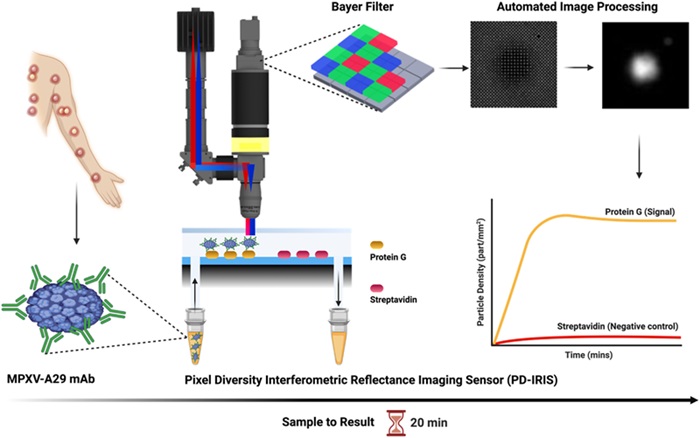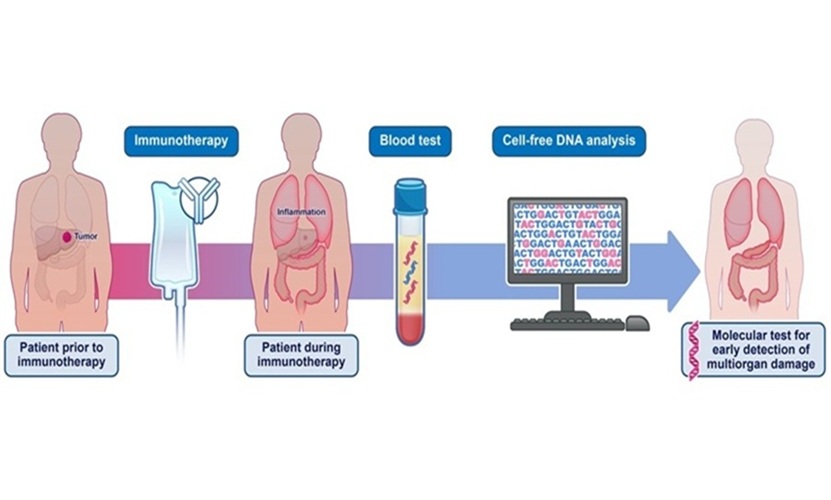Optical Biosensor Rapidly Detects Monkeypox Virus at Point of Care
|
By LabMedica International staff writers Posted on 18 Nov 2024 |

A new variant of human mpox has caused a mortality rate of approximately 5% among those infected in the Democratic Republic of the Congo since 2023, with many of the victims being children. This variant has since spread to multiple other countries. On August 14, the World Health Organization declared the outbreak a Public Health Emergency of International Concern. In addition, another variant of mpox, which is less fatal, triggered an outbreak that has now spread to more than 100 countries since 2022. The symptoms of mpox, such as fever, pain, rashes, and lesions, closely resemble those of other viral infections, making it difficult for clinicians to differentiate monkeypox from similar diseases just by observation. Currently, polymerase chain reaction (PCR) is the only approved diagnostic method for mpox. However, PCR is costly, requires a lab, and can take several days or even weeks to return results. Therefore, there is a pressing need for more efficient and cost-effective diagnostic tools to control the spread of mpox and prepare for potential future pandemics.
Researchers from the University of California San Diego School of Medicine (La Jolla, CA, USA), Boston University (Boston, MA, USA), and their colleagues have developed an optical biosensor capable of rapidly detecting monkeypox, the virus responsible for mpox. This innovative technology could enable clinicians to diagnose the disease at the point of care, eliminating the need to wait for lab results. In their study, the team utilized a digital detection platform called Pixel-Diversity interferometric reflectance imaging sensor (PD-IRIS) to identify the virus. They tested samples taken from the lesions of a patient with confirmed mpox by incubating them with monoclonal monkeypox antibodies that bind to the virus's surface proteins. This virus-antibody complex was then transferred into small chambers on silicon chips on the sensor’s surface, which were treated to fix these nanoparticles.
The sensor was activated by shining precise red and blue light wavelengths simultaneously on the chips, causing interference. This interference resulted in subtle variations in the response when the virus-antibody nanoparticles were present. A color camera captured this small signal and counted individual particles with high sensitivity. The team also analyzed samples from the herpes simplex virus and cowpox virus, which have similar clinical symptoms to mpox. The results, published in Biosensors and Bioelectronics, showed that the biosensor could effectively distinguish mpox from these other viruses, demonstrating its specificity in identifying monkeypox. Within two minutes, the test could confirm whether a patient has monkeypox, with the entire process, from sample collection to real-time data analysis, taking about 20 minutes.
In a clinical setting, the speed of this test would enable healthcare providers to diagnose mpox much more quickly than the traditional method of sending samples to a lab. This rapid diagnosis is especially crucial in regions with limited healthcare resources, as it can help curb the spread of the virus. Early diagnosis also allows clinicians to initiate treatment more promptly, if available. The researchers plan to mass-produce these tests in kit form for distribution to clinics, further reducing costs. A single kit could potentially test for multiple viruses, such as syphilis or HIV. The team aims to commercialize the technology, not only to address the urgent need for rapid mpox testing in the Democratic Republic of the Congo but also to prevent outbreaks from escalating into pandemics. However, the researchers emphasize that government support will be necessary to make these diagnostic tools available, as there is limited market interest in addressing future health threats.
Latest Technology News
- Machine Learning Models Diagnose ALS Earlier Through Blood Biomarkers
- Artificial Intelligence Model Could Accelerate Rare Disease Diagnosis
- AI Saliva Sensor Enables Early Detection of Head and Neck Cancer
- AI-Powered Biosensor Technology to Enable Breath Test for Lung Cancer Detection
- AI Model Achieves Breakthrough Accuracy in Ovarian Cancer Detection
- Portable Biosensor Diagnoses Psychiatric Disorders Using Saliva Samples
- Cell-Sorting Device Uses Electromagnetic Levitation to Precisely Direct Cell Movement

- Embedded GPU Platform Enables Rapid Blood Profiling for POC Diagnostics
- Viral Biosensor Test Simultaneously Detects Hepatitis and HIV
- Acoustofluidic Device to Transform Point-Of-Care sEV-Based Diagnostics
- AI Algorithm Assesses Progressive Decline in Kidney Function
Channels
Clinical Chemistry
view channel
Online Tool Detects Drug Exposure Directly from Patient Samples
Doctors often rely on patient interviews and medical records to determine what medications a person has taken, but this information is frequently incomplete. People may forget drugs they used, take over-the-counter... Read more
Chemical Imaging Probe Could Track and Treat Prostate Cancer
Prostate cancer remains a leading cause of illness and death among men, with many patients eventually developing resistance to standard hormone-blocking therapies. These drugs often lose effectiveness... Read moreMolecular Diagnostics
view channel
CLIA Test Identifies Head and Neck Cancer Recurrence from Post-Surgical Lymphatic Fluid
While the lymphatic system’s critical role in metastasis has long been recognized, routine access to patient lymph has been elusive. Now, a non-invasive process can access lymph through the collection... Read more
New 15-Minute Hepatitis C Test Paves Way for Same-Day Treatment
Chronic hepatitis C infection affects an estimated 50 million people worldwide and causes around 242,000 deaths each year, largely due to cirrhosis and liver cancer. Although the infection is curable with... Read moreHematology
view channel
MRD Tests Could Predict Survival in Leukemia Patients
Acute myeloid leukemia is an aggressive blood cancer that disrupts normal blood cell production and often relapses even after intensive treatment. Clinicians currently lack early, reliable markers to predict... Read more
Platelet Activity Blood Test in Middle Age Could Identify Early Alzheimer’s Risk
Early detection of Alzheimer’s disease remains one of the biggest unmet needs in neurology, particularly because the biological changes underlying the disorder begin decades before memory symptoms appear.... Read more
Microvesicles Measurement Could Detect Vascular Injury in Sickle Cell Disease Patients
Assessing disease severity in sickle cell disease (SCD) remains challenging, especially when trying to predict hemolysis, vascular injury, and risk of complications such as vaso-occlusive crises.... Read more
ADLM’s New Coagulation Testing Guidance to Improve Care for Patients on Blood Thinners
Direct oral anticoagulants (DOACs) are one of the most common types of blood thinners. Patients take them to prevent a host of complications that could arise from blood clotting, including stroke, deep... Read moreImmunology
view channel
Blood Test Could Detect Adverse Immunotherapy Effects
Immune checkpoint inhibitors have transformed cancer treatment, but they can also trigger serious immune-related adverse events that damage healthy organs and may become life-threatening if not detected early.... Read more
Routine Blood Test Can Predict Who Benefits Most from CAR T-Cell Therapy
CAR T-cell therapy has transformed treatment for patients with relapsed or treatment-resistant non-Hodgkin lymphoma, but many patients eventually relapse despite an initial response. Clinicians currently... Read moreMicrobiology
view channel
Blood-Based Diagnostic Method Could Identify Pediatric LRTIs
Lower-respiratory tract infections (LRTIs) are a leading cause of illness and death worldwide, and pneumonia is the leading infectious cause of death in children under five, claiming the lives of over... Read more
Rapid Diagnostic Test Matches Gold Standard for Sepsis Detection
Sepsis kills 11 million people worldwide every year and generates massive healthcare costs. In the USA and Europe alone, sepsis accounts for USD 100 billion in annual hospitalization expenses.... Read moreRapid POC Tuberculosis Test Provides Results Within 15 Minutes
Tuberculosis remains one of the world’s deadliest infectious diseases, and reducing new cases depends on identifying individuals with latent infection before it progresses. Current diagnostic tools often... Read more
Rapid Assay Identifies Bloodstream Infection Pathogens Directly from Patient Samples
Bloodstream infections in sepsis progress quickly and demand rapid, precise diagnosis. Current blood-culture methods often take one to five days to identify the pathogen, leaving clinicians to treat blindly... Read morePathology
view channel
Rapid Low-Cost Tests Can Prevent Child Deaths from Contaminated Medicinal Syrups
Medicinal syrups contaminated with toxic chemicals have caused the deaths of hundreds of children worldwide, exposing a critical gap in how these products are tested before reaching patients.... Read more
Tumor Signals in Saliva and Blood Enable Non-Invasive Monitoring of Head and Neck Cancer
Head and neck cancers are among the most aggressive malignancies worldwide, with nearly 900,000 new cases diagnosed each year. Monitoring these cancers for recurrence or relapse typically relies on tissue... Read more
Common Health Issues Can Influence New Blood Tests for Alzheimer’s Disease
Blood-based tests for Alzheimer’s disease are transforming diagnosis by offering a simpler alternative to spinal taps and brain imaging. However, many people evaluated at memory clinics also live with... Read more
Blood Test Formula Identifies Chronic Liver Disease Patients with Higher Cancer Risk
Chronic liver disease affects millions worldwide and can progress silently to hepatocellular carcinoma (HCC), one of the deadliest cancers globally. While surveillance guidelines exist for patients with... Read moreIndustry
view channel
BD and Penn Institute Collaborate to Advance Immunotherapy through Flow Cytometry
BD (Becton, Dickinson and Company, Franklin Lakes, NJ, USA) has entered into a strategic collaboration with the Institute for Immunology and Immune Health (I3H, Philadelphia, PA, USA) at the University... Read more




 assay.jpg)














